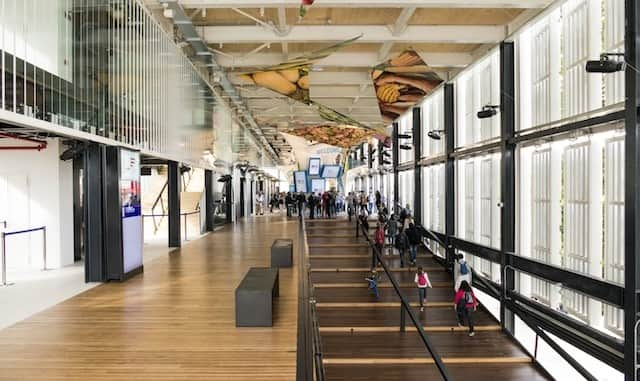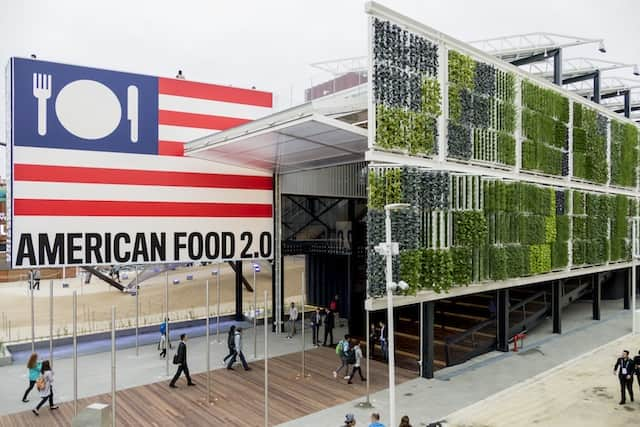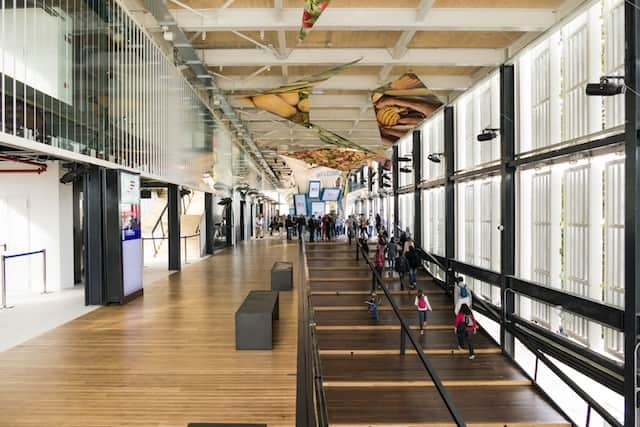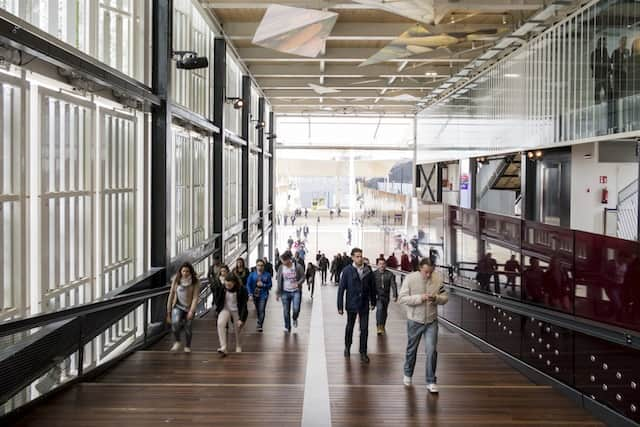
American white oak deck features in the USA pavilion at ‘Milan Expo 2015’
White oak floor complements the rest of the decking, which has been recycled from 100-year-old salvaged timber from the original Coney Island boardwalks
The American Hardwood Export Council (AHEC), the leading international trade association for the American hardwood industry, has supported the USA pavilion at the Milan Expo 2015 with a stunning 500m2 white oak deck. The American hardwood floor runs the length of the pavilion on the first floor, where the main exhibition area is located. The white oak was chosen by New York architect James Biber, whose practice designed the pavilion. Biber wanted a classic-looking hardwood to blend in and complement the rest of the decking, which has been recycled from 100-year-old salvaged timber from the original Coney Island boardwalks.
In line with the overall theme of the Milan Expo 2015 – ‘Feed the Planet, Energy for Life’ – the USA Pavilion, named ‘American Food 2.0, United to Feed the Planet’ shows just how engaged the U.S. is in global food security, food innovation and has become a center for the best food on the planet. As such, the pavilion opens its airplane hangar sized door to the main pedestrian approach, like an invitation to enter, and is as open, airy and breezy as a building can be. The boardwalk (made of recycled lumber from America’s boardwalks) rises to the second level, concealing a defined exhibition below and is the main forum for self-guided viewing.
According to Biber, the main architectural feature is a football-field-length Vertical Farm featuring a variety of harvestable crops in a vertical array. It is as though a typical horizontal field was rotated to become the side of a building. Biber reiterates that it is not a proposal for serious urban or vertical farming, which is usually indoors, but more of a didactic display talking about the past, present and future of the American farm, and the American diet. The pavilion itself then is a scaffolding for ideas, a rethinking of the nature of the Expo pavilion and of America as a force in the food world.
Finished with one coat of clear anti-oxidant oil, the white oak decking was manufactured in Italy by Imola Legno. Comprising profiled random length strips, 20mm in thickness and 80mm wide, the floor was laid using a hidden clip mounting system with 5mm gaps between each strip. Stainless steel fasteners were used and the decking can easily be taken up without damage either for routine maintenance or re-use, thus considerably extending its life expectancy. Although the USA Pavilion is a temporary exhibit, the deck is fixed with an innovative click system allowing it to be readily relocated, reused and maintained. It should last no less than 20 years and, with appropriate maintenance, for as long as 50 years.
The USA pavilion has a very strong sustainability theme featuring a vertical farm, the latest energy efficient technologies and reclaimed wood. But one of the strongest environmental messages is communicated through the use of the sustainably produced new American oak. AHEC, using its ground breaking Environmental Life Cycle Assessment (LCA) research, has produced a full cradle to grave environmental profile for the white oak deck. Data on the forestry, sawmilling, drying and shipping impacts of sending the white oak lumber to Italy were combined with data collected during manufacturing. Included in the assessment are all the non-wood materials (glues, oils and fixings) transport, installation and predicted life expectancy. At the end of its life the deck can either be recycled or burnt as a renewable fuel.
“The American white oak resource is not only renewable but is expanding. The resource is so large and growing so rapidly that it takes less than 25 seconds for the white oak harvested to manufacture the deck installed at the Milan Expo to be replaced in the forest. The deck is better than carbon neutral on a cradle-to-grave basis. The carbon emissions associated with delivery of materials and fabrication of the deck are more than offset by energy generated from wood offcuts and disposal at end of life. Much of the energy input for production of the deck derives from renewables. For as long as the deck remains in use it will store the equivalent of 14.5 metric tons of CO2 equivalent,” concludes Roderick Wiles, AHEC Director for Africa, Middle East, South Asia and Oceania.
About AHEC:
The American Hardwood Export Council (AHEC) is the leading international trade association for the U.S. hardwood industry, representing the committed exporters among U.S. hardwood companies and all the major U.S. hardwood production trade associations. AHEC runs a worldwide programme to promote American hardwoods in over 50 export markets, concentrating on providing architects, specifiers, designers and end-users with technical information on the range of species, products and sources of supply. In addition, AHEC also produces a full range of technical publications. For more information, please visit: www.americanhardwood.org.
About American white oak
American white oak has a creamy colored sapwood and a light to dark brown heartwood. White oak is mostly straight grained with a medium to coarse texture, with longer rays than red oak, producing a distinctive and attractive grain pattern. American white oak is widely available and is a popular choice in export markets around the world for many furniture, flooring and joinery manufacturers due to its color consistency and the high volume of square edged lumber production, and veneer availability. The wood is hard and heavy, with medium bending and crushing strength. It is low in stiffness, but very good in steam bending.
About Imola Legno
Imola Legno is Italy’s leading timber distribution company with a great passion for wood and for its enormous versatility. The company offers customized semi-finished products suitable for different industries. Imola Legno is aware of its environmental responsibility towards the world’s forest resources and therefore is committed to deliver only products that are legally sourced. For more information, please visit: www.Imolalegno.com.
About Biber Architects
Biber Architects is a tightly organized, highly experienced team of architects and designers led by James Biber, FAIA LEED. Trained first as a biologist, then as an architect, Biber has practiced architecture in a multi-disciplinary environment for more than 25 years. His work centers on a belief that architecture, as an expression of identity, is inseparable from its language of form and tectonics. Biber’s projects include the Harley-Davidson Museum in Milwaukee, private oceanfront homes in the Hamptons, The Brooklyn Public Library, NYC Department of Design and Construction, CUNY’s Macaulay Honors College, the National Millennium Time Capsule and dinnerware for Umbra among others. For more information, please visit: www.biber.co.



